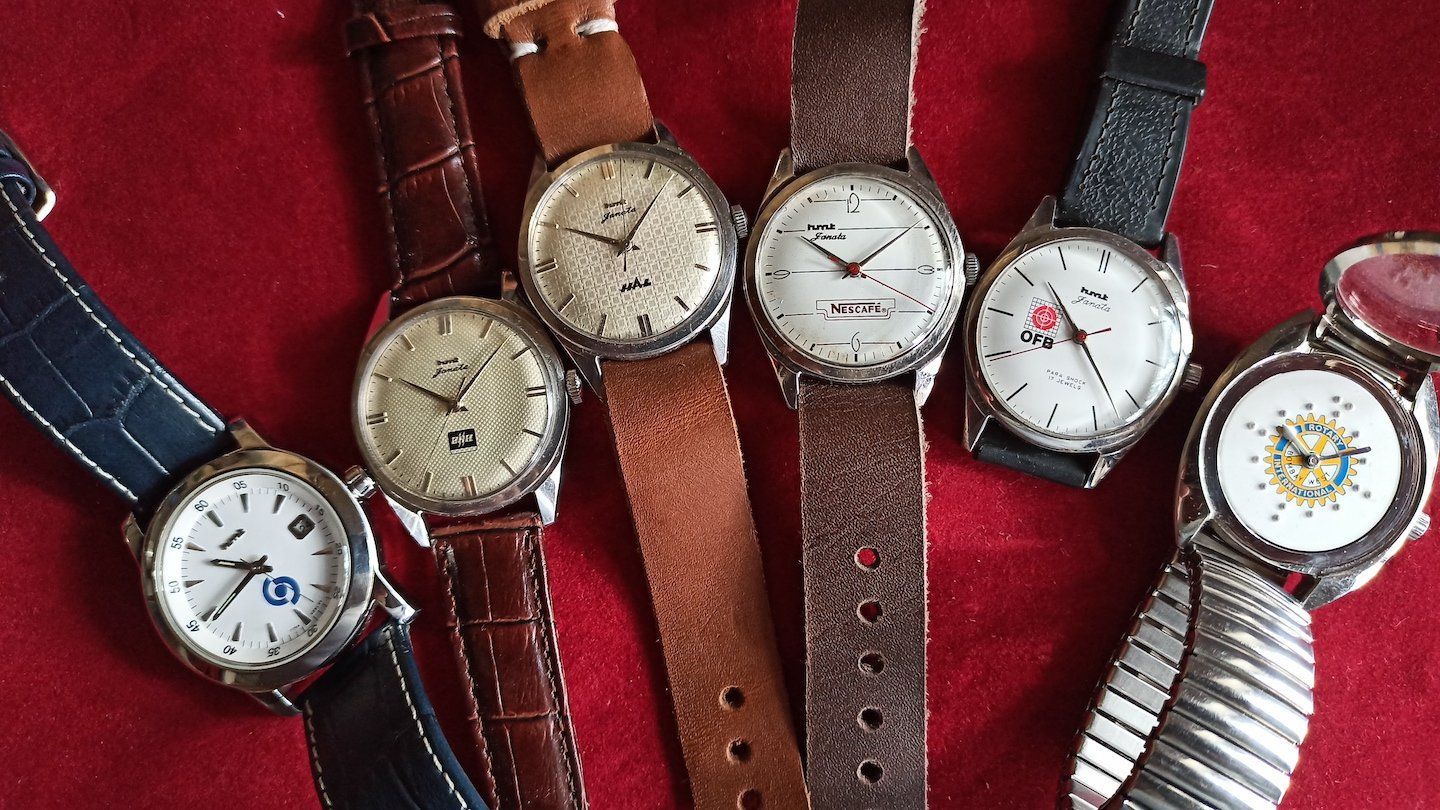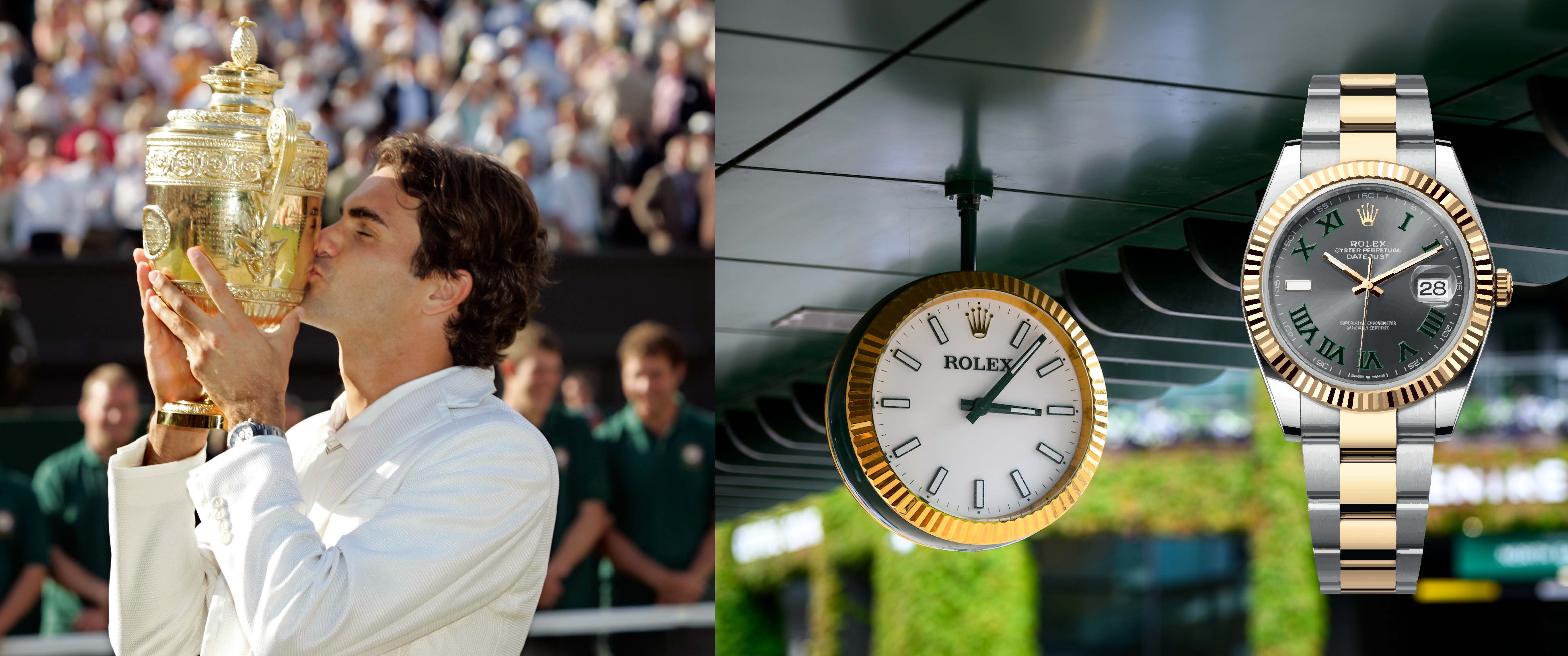HMT Watches: A walk down the memory lane
By Ronie A. Ghosh @horonation, Member - RedBar Bombay
"...At the stroke of the midnight hour, when the world sleeps, India will awake to life and freedom...", this line was a part of the greatest speech "Tryst with Destiny" that Pandit Jawaharlal Nehru made towards the stroke of midnight on August 14, 1947; the sun was finally setting for the British Empire and India was witnessing its rebirth as an independent nation. The abyssal challenge of our people's fight for freedom was achieved, now the challenge of industrialization, modernization, and self-reliance of the newly formed independent India was upon us. Thankfully, we had the greatest minds of their time like M. Visvesvaraya, Homi J. Bhabha, Vikram Sarabhai, and many others as well as visionaries like Pandit Nehru himself, Sardar Vallabhbhai Patel and others who propelled the accomplishments one at a time taking giant strides towards the ultimate goal.
Independence and the big step for the development
From rudimentary to advanced level machinery, we needed a bottom up approach, thus in the year 1953, Hindustan Machine Tools, a public sector undertaking or what we know today as HMT was set up. The initiative that was taken to produce mother machines was industrially and strategically very important for the growth and development of India. The term ‘Machine Tools' here itself is self explanatory where it is well understood that these are means to develop any kind of advanced machinery, starting from aircraft to missiles and from ships to submarines. In Pandit Nehru's words this establishment was revered as one of the ‘Temples of Modern India’.
But within a decade a necessity was felt where an important piece of timekeeping was missing from the wrist of common masses. A simple and rugged watch for the Indian public. At that time watches were mostly imported or parts were imported and then assembled in India. Like some of the watch brands, then available in India were West End, Anglo-Swiss, etc., and were out of reach for most of the public due to price and limited availability. By that time HMT was quite confident in their experience to manufacture precision components. In 1961, HMT was entrusted with setting up a watch manufacturing unit in India. But this was a completely unknown territory for HMT then, so they collaborated with Citizen Watches Co., Japan; and set up the first watch factory in Bangalore in the same year. The foundation stone was laid by Mr. Manubhai Shah, the then Minister for Industry. The factory was completed by 1963 and was inaugurated on 15th August 1963 by then Chairman Mr. M.K. Mathulla. This factory was named as 'Watch Factory-I' or WFB-I (Watch Factory Bangalore 1) and the first batch of hand-winding mechanical wristwatches was manufactured here.
The evolution of an Indian Horology
But before stepping into watch models, it's vital to know about the development of the watch movement. A very reliable workhorse movement from the house of Citizen, Cal. 0201 was employed as a base movement. Due to the size and construction of this movement, it was predestined to run reliably for many years without service which was an absolute must in India. The Citizen 0201 is a hand-wind movement with 17 jewels and a large Glucydur balance, which is incorporated with two Citizen Parashock (patented) protections. For some later projects, the 21 jewels variation of the 0201 movements was also used. But for then, the HMT '020' licensed movement was derived from Citizen '0201'. It is constructed in a traditional way with a direct driven center second and a center minute wheel. This movement runs with 18000 bph and has a pallet lever escapement system. The HMT 020 movement was then modified into many variations like:
Caliber HMT 0231 which is the current standard 3 hands hand-winding movement. e.g. Pilot, Janata, Kohinoor etc.
Caliber 0232 movement with 2 hands hand-winding movement where seconds hand is not present. e.g. Sachin, Neeraj, etc.
Caliber 0233 movements with hand-winding side sub-seconds hands. e.g. Kaushal, Side seconds pocket watch
Caliber 1809 movement with hand-winding, 3 hands, and dater function. e.g. Ravi, Tareeq
Modified hacking movement for Indian Air Force issued Pilot's watch with sterile dial around 1975 Indo-Pak war.
An anticlockwise movement where watch hands moved anticlockwise.
The 21 Jewels Hand winding movement version of Citizen Caliber 0201 was licensed as 'Citizen HMT 21 Jewels' and it also mentioned 'Japan' on the escapement assembly citing that these movements were imported and were used on one model of watch HMT Jhelum. There was a 17 jewels-based Citizen hand-winding Ladies' watch movement known as the Caliber 2340A movement, which was smaller. HMT licensed and modified it as:
HMT Caliber 2345 e.g. Ashwini, and
HMT Caliber 0185 movement. e.g. Supriya. These were the second movements to be licensed from Citizen.

The first batch of watches that were produced was 500 numbers of 'HMT Citizen' for men and 300 numbers of 'HMT Sujata' for ladies but with 17 jewels based on 020 movements as per HMT requirement. The same first batch was released by Pandit Nehru for the general public in the same year. Popularity and demand for affordable, locally available, and serviceable watches kept on increasing day by day and HMT decided on expansion.

In 1972, 'Watch Factory-II' or WFB-II (Watch Factory Bangalore 2) was established in the same premises for the manufacture of automatic watches that employs a weighted unbalanced rotor attached to the winding mechanism of the watch. This enabled the winding of the watch by wrist movement of the user. This factory was inaugurated by Shri. C. Subramaniam, the then Minister for Heavy Industries.
HMT derived its Automatic movements from Citizen-manufactured 21 Jewels Automatic movement calibers 6500 series namely 6501, 6509 (21600 bph), and 6569 (28800 bph) which were almost identical with minor variations. These were unidirectionally winding movements with Glucydur annular balance, and Parashock patented shock protection with pallet lever escapement. The version HMT renamed after getting the movement licensed was HMT Caliber 6500/6501 automatic movement. Parallel to this Caliber 6500, there were some variations made to get the similar bidirectional rotor winding Caliber 6900 series to be used in later produced models of the watches. This was the third movement to be licensed after the hand-winding 0231/0201 movement and 2345 ladies' hand-winding movement. This movement had variations like:
Automatic Caliber 6500 with three hands, hand-winding and automatic, day-date (date quick set). e.g. Automatic, Rajat, Kanchan, etc.
Modified Automatic Caliber 6500 4 hander with 4 hands, three for time H:M:S and one Date/Day Pointer hands. e.g. Leo, Taurus, Sweekar (day pointer hand and dater).
Modified Automatic Caliber 6500 President with President style complete day window at 12 o'clock. e.g. Pinaki, Rajat variation.
Modified Automatic Caliber 6500 Dater with 3 hands, date function only. e.g. ADSL 02, 03, 04
For Ladies Automatic watch, Caliber imported Citizen 6651 hi-beat movement was employed as HMT Caliber 6600. e.g. Archana. HMT referred to these movements as "HMT 6500/6900/6300 series" only. The nomenclature above has been within the HMT watch collectors' lingo to discuss watch and movement variations among themselves.
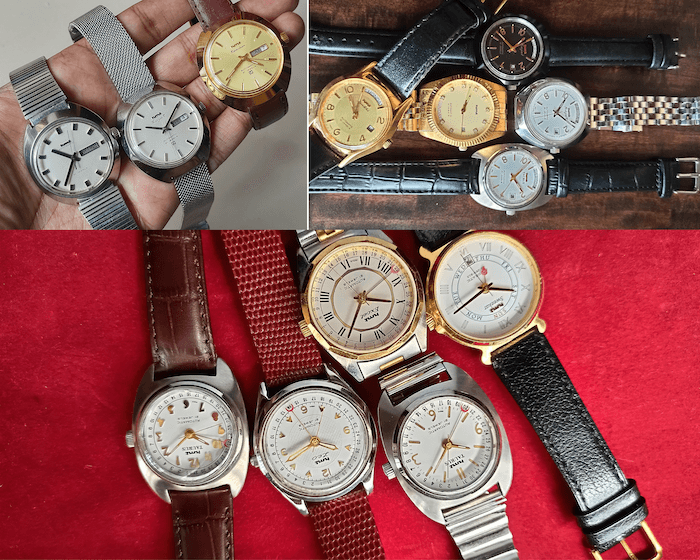
Around 1977 HMT also imported and modified Miyota 8200 movements as per the Indian market. Miyota is a subsidiary of Citizen itself, but for the export market. HMT did fit the day wheel with Hindi font one and date in Arabic numerals as it were. Few models then launched were Kedar Premium, Kanchan Premium, Kailash etc.
The self-sufficiency and steps ahead
On June 29, 1970 the government of India accorded approval for setting up another watch factory but now in Kashmir, exclusively with technical knowhow from previous Factory I and II in Bangalore. Foundation stone was laid on May 13, 1971 by Mr. G.M. Sadique, the then Chief Minister of Jammu and Kashmir. In 1975 it was finally inaugurated by Smt. Indira Gandhi, the then Prime Minister of India. Finally "Watch Factory-III" was set up in Zainakote, Srinagar in the state of Jammu & Kashmir with an annual target of producing 3 lakh hand-winding watches. This factory was later an independent subsidiary within HMT Ltd. itself as HMT Chinar Watches Ltd. by year 2000. Some of the unique and sought after watches from this factory are HMT Chinar, Kamal, Sportstar, Sports watch, Shiva, some variations of Janata, Kohinoor, Pilot and Avinash. Plus it also contributed to some quartz models as well in future. The uniqueness of the dial of the Chinar and Kamal model was the imprint of "Chinar leaf" on the dial of the respective watches. During 1982 the 9th Asian Games held in New Delhi was commemorated with many sports watches produced by HMT Chinar Factory e.g HMT Sportstar, HMT Sports watch etc. During later years of cross border infiltration and increased occurrence of terrorism and separatist activities, the production and functioning of this factory was highly affected.
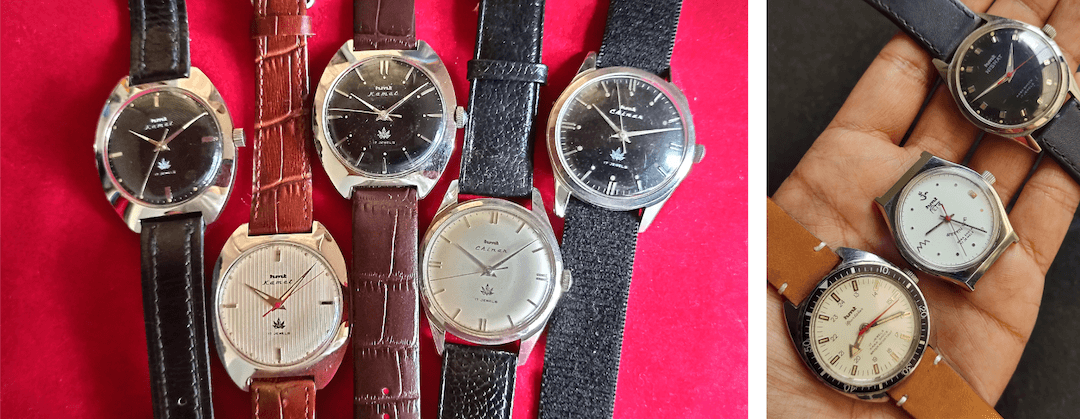
Central Research and Development was established for development of various components and activities in the watch units around 1978. The Horological Inspection Institute was established in the line of the Japan Horological Institute with support from UNIDO and UNESCO. These establishments not only gave us self-reliance in terms of in-house production of movements and watches, but also established a system for inspection and quality control required by watch manufacturing units. Subsequently 'Specialized Watch Case Division' was started to manufacture cases of different shapes and sizes.
In 1985, Watch factory at Bangalore was further expanded and HMSA unit was set up to manufacture main spring, hair spring and shock absorber components. With this and above in house processes HMT completely acquired the technology of mechanical watch-making, producing 100% components in house.
From beginning and later in the continuing years, the complete process of case manufacture includes procurement of raw Steel billets followed by raw material blanking to desired case size, piercing and boring the case for movement and dial placement, forming by turning and lathe process, trimming the excess metal from case blanks, drilling, boring and chamfering the edges and crown stem tube, machining upper and lower surfaces followed by polishing and buffing. The finished watch case is then forwarded to the assembly line for QC and watch assembly. The Brass cases have a different production process where the case is forged by hot forming process using heated raw brass billet and pressing dies. Then the raw cases are machined, finished and ion/chemical plated with chrome or gold as desired. The Stainless Steel casebacks on the watches are formed using sheet blanking, forming of the edges, machining of the edges for screw down or push fit type, polishing and buffing and finally caseback serial numbering and HMT logo stamping. All these were achieved mostly with HMT machine tools and only a few machine tools were imported for specialized work. The dial itself involved blanking of brass plate then during initial years of production from 1961-69 coined dials were made where surface of watch dial was machined out of a single plate, on which the indices and markers were painted, later during 1970-80 printed dial were manufactured, after precise machineries were set up around 1980-90 inserted dials were manufactured where metal inserts were attached through piercings on the dials, then around 1990-2000 computer graphics were involved and mass production of screen printed dials was carried out for variety of quartz watches as well, in later 2000s multifunction dials and skeleton dials were made for skeleton mechanical/automatic, chronographs and multifunction quartz watches.
The Indian Military and HMT
HMT was tasked with providing supply kit issued watches to the Indian Army and Indian Air force around 1970-80's. One of the watch models HMT Jawan was conceptualized by HMT Chinar factory with unmarked caseback. These watches were meant to be supplied through OFB or Ordnance Factory Board where the caseback markings were done for serialization as per military stock issue code system. The casebacks are usually stamped with the famous 'Pheon' marking or 'Broad Arrow' markings. Since our military coding is similar to the British one, the watch caseback codes started with W10 followed by 6645 which is very similar to the general service watches code supplied by CWC (Cabot Watch Company) to the British Army. "These HMT Jawan were issued to NCOs (Non Commissioned Officers) of Indian Army" as it was recalled by Col. S.K. Rathi, an Army veteran and father of Mr. Vikram Rathi, a Redbar Bombay member during a recent meetup organized by The Hour Markers. Other than that HMT watches were also available through unit run canteens where they were priced with a good subsidy but those were non-military ones that could be purchased for personal use. The HMT Jawan watches were later taken back and decommissioned. These watches can still be found in hundreds of numbers with old watch shops where decommissioned watches were repaired and resold.
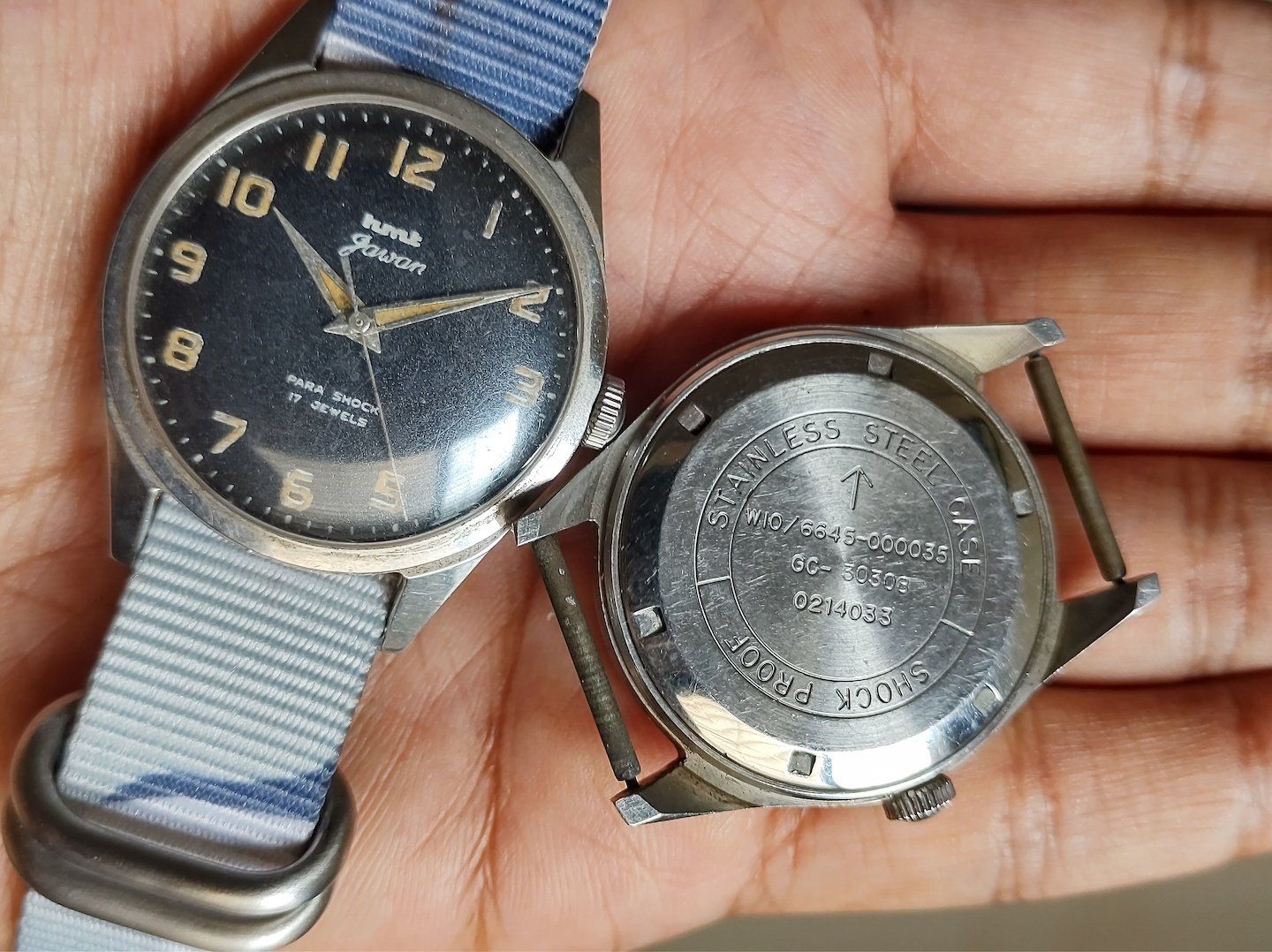
One very trivial watch and extremely rare HMT watch is an HMT Pilot's watch issued exclusively to Fighter Pilots of Indian Air Force flying the English Electric Canberra bomber plane that played a pivotal role in 1971 Indo-Pak war. The plane did have a cockpit clock but no chronograph or countdown feature. This watch helped in timing of maneuvers and bombing. In this watch the standard 0231 was modified in such a way that movement was hacked during setting of time and the watch could be timed accurately to seconds during the time check of all the wingman pilots in a sortie. The main purpose of hacking seconds was mainly coordination among military, railways, signals units etc. The caseback on this watch was also marked with 306B which is similar to 6B marked British Royal Air Force Pilot's watches.
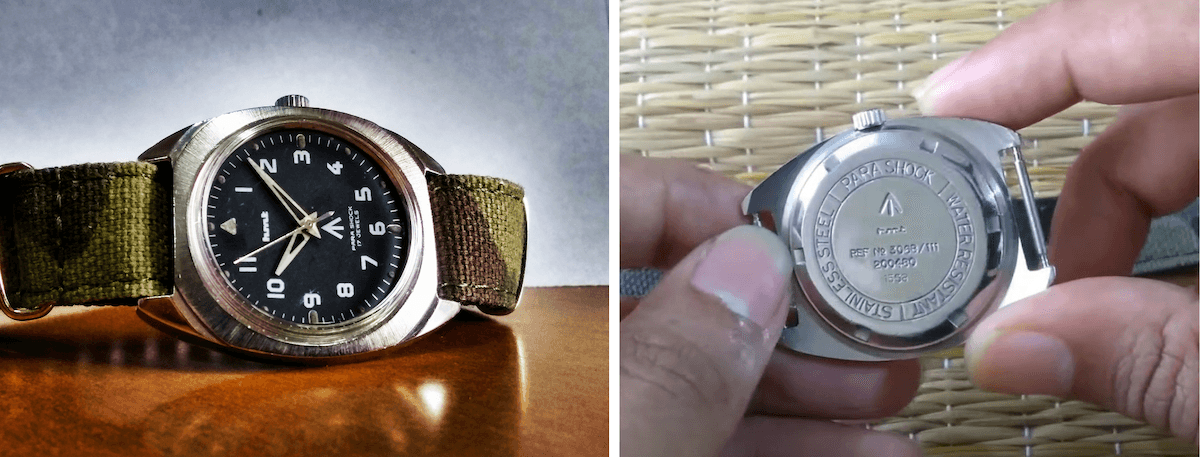
The complete deciphering of the caseback codes of either of the two watches has not been made public by HMT or Military either. It may be due to information getting lost in time as decades old decommissioned materials are irrelevant.
The Quartz Crisis and further strategy
The quartz watches came in 1969, and we all know what it did to the mechanical watch industry then. Many Swiss watch brands amongst others had to shut their business due to rapid demand of quartz watches for their longevity, less maintenance and freedom from daily winding as in a mechanical watch. Along with that the world was getting electronic and it was a matter of pride wearing an electronic device on the wrist. Now the scenario is turning to mechanical watches again due to the retro appeal, collector's spirit and possibilities that can be achieved in a mechanical watch. But as quartz watches were creating a buzz with newer Japanese brands entering the market like Seiko and Citizen the HMT Ltd. felt the need to go with the market and decided to explore possibilities in the quartz watches. In 1978 "Watch Factory-IV" was established in the Tumakuru area of Karnataka, also known as WFT. The production of analog quartz watches started in 1986 with assistance from Citizen Watch Co., Japan and the annual target of this unit was around 10 lakh Quartz analog watches per year which was necessary due to increasing population and demand in modern India. Variety of case and dial designs were introduced owing to the introduction of tool rooms, ebauche and press shops, heat treatment and plating setups etc. Alongside it was absolutely necessary to provide tools training to their employees and newcomers in HMT, hence Precision Tools Training center was established. But this craze of quartz watches did hit the HMT mechanical watches production as the materials for mechanical watch capacity of 20 lakhs were subsequently converted to quartz watches production including HMT Cal. 2150, 2050, 2080, GL-30 movements developed and initially procured from Citizen. Imported movements like Miyota 0S10 quartz chronograph movements etc. were used as well. Later only main printed circuit boards as per HMT dimensions and specifications used as quartz watch mainboards were imported from Taiwan and assembling of electronic components was done in-house to develop the quartz watch line.

In 1985 the "Watch Factory-V" was established at Ranibagh, Uttarakhand, also known as WFR and was inaugurated by the then Prime Minister Mr. Rajiv Gandhi. The area of Ranibagh used to be a backward area then but industrialization rapidly grew then after HMT watch factory was established and soon townships, schools, hospitals, playgrounds and community centers were established. The factory produced some iconic watches like HMT Braille watches, HMT Jhalak, Pocket watches etc. alongside quartz watches.

In large clock manufacturing HMT has been a key player as well. Since 1985, HMT Watches had been involved in making Floral Clocks, Solar Clocks, International Clocks and Tower Clocks.
Digital age, Exports and Collaborations
In some limited productions and launches, HMT also outsourced parts of analog-digital combo watches known as Ana-Digi from modules imported directly from Citizen Co. Japan and purely digital watches known as Astra to Sikkim State Government run SITCO corporation. The modules used in the SITCO made watches were mostly imported from Taiwan and Korea. SITCO also assembled mechanical Janata watches for HMT for a very short period of time.
Many watches were made to export and are some of the rare collectibles now. For example, some variations of Janata, Kohinoor, Pilot, Rekha and standard automatics were export models that were supplied to countries like Japan and others for a short period of time. Watch brands like Ryon also outsourced watches from HMT production under their own brand name. Mostly international orders were placed in bulk whilst the HMT international wing used to deal with foreign countries like Saudi Arabia, France, Germany and Japan.
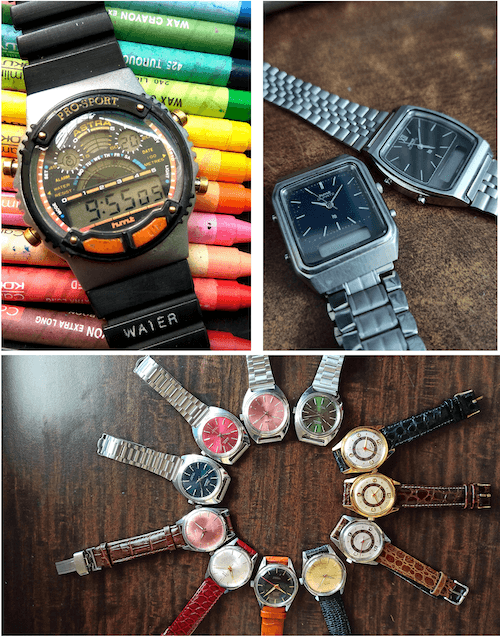
Commemorations of Indian Industrialization, History, Culture and Language
Many companies no matter government or private did commission HMT watches in producing watches in bulk for distribution among their employees as a remuneration for milestone achievements, good work and jubilee celebrations. Watches of a variety of models like Janata, Pilot, Kohinoor, Avinash, other quartz watches etc. were customized with company logos and were distributed. The collectors have found many of such watches with retired employees of those companies including HAL, OFB, Nestle, BSNL, BHEL, MTNL, ISRO and many state owned banks like SBI, BOI amongst others.
Parallel to this there were watches marked with institution logos of places with religious and cultural importance like Tirupati trust, Karnataka Flag and emblem, Golden temple Amritsar, Siddhi Vinayak etc.
HMT also commemorated watches with known historical figures and important events of history of India such as Pt. Jawaharlal Nehru, Dr. B.R Ambedkar, Mahatma Gandhi and events like 50 years of Independence, 75 years of Independence, commemoration of new Parliament House in 2022 etc.
Competition, Globalization and Legacy
During the 70s and 80s there were several competitions to HMT namely Allwyn watches that was established by collaboration of Hyderabad state government with Seiko Corporation, Japan and Titan watches that was a collaboration between Tata and Tamil Nadu state owned TIDCO. Apart from these many small watch brands like Hegde-Golay, Timestar, Amar watches, Olympic watches were also established around that time. It left people with many options but still HMT was widespread and had larger geographical availability. By the 90s many foreign investments, collaborations, imports started in the Indian market and the same happened with watches as well, and now customers had options beyond HMT.
During this time HMT also started outsourcing cases, movements and other parts from other countries and started assembling in their factories, but keeping up with the fast business alongside private players was difficult for this government-run organization. However, to cater to modern design choices, the existing models were upgraded with new look, imported movements like Miyota automatic calibers 8205 series, 8N24 skeleton movements, 82S0 hackable movements etc. Many hand-winding and automatic models were launched with dial variations. A new line of quartz chronographs were launched as well with Miyota 0S10/20 quartz movements. Premium quartz models like the Roman series were also launched. Many showrooms were opened to stock quartz watches and authorized distributors for HMT watches were established in small and big towns alike.
However, despite many attempts to keep up with the ever-growing pace and trend of the modern Indian market, it was very difficult for HMT to sustain the business and the company started making losses in the watches division segment. It is speculated that due to slow procedures in the management within HMT, it was difficult to keep making profits as before. In those years around 1987 mechanical watches were considered outdated and HMT didn't fully comprehend the massive requirement of quartz watches that other companies did, so HMT basically didn't push the quartz production until other companies were way ahead in the quartz game. Lack of innovation, team spirit and under utilization of the facilities were also an internal problem within HMT. Around 90s the stock market share of HMT was eroding consistently, finally with a massive mounting loss of 2500 crores the government shut down the last plant in 2016.
The Collector's Pride
When it comes to the collectors of HMT watches, one cannot deny the guidance and inspiration of Late Mr. Prashant Pandey, who inspired collectors in identifying and collecting HMT watches for more than a decade. Many of the facts included in this article were once stated to me by him and later researched upon by talking to ex employees of HMT, other HMT collectors, watchmakers who have had a long stint with HMT movements, former authorized dealers of HMT watches and so on. There are many groups on Facebook that are a place for knowledge sharing and buy/sale of vintage and sometimes rare HMT watches, like HMT Brotherhood, HMT Watch Collectors etc. Majority of people prefer to wear HMT as HMT mechanical watches are eco-friendly as well and HMTs are rugged, robust, budget friendly and sustainable compared to Chinese watches and movements in the mechanical category. There is one big factor why people like to collect HMT and that is availability of namesake Hand Winding/Automatic watch models. If one looks through the HMT Catalog, then you may find gamut of models with common Indian men and women's names such as Anand, Vijay, Pankaj, Siddharth, Avinash, Suraj, Naveen, Akash, Praveen, Vishal, Sachin, Abhijit, Amitabh, Gagan, Karan etc. and many more as well as Sujata, Kajal, Dipti, Supriya, Ashwini, Shilpa, Rajni and so on. It is often jokingly said among HMT collector's community that if you are looking for baby names then refer to an HMT Catalog.
What gives a pride in collecting HMT watches is the nostalgic feeling of the 80s and 90s period when getting a watch as a gift or buying it was a big achievement. A watch that can last for decades passed on from generations is something worth collecting. However, HMT may not suit many collector’s expensive lifestyle and luxury watch collection, but one rarely knows the sheer luck of finding a rare piece in a small shop, and that's when it happens, the "Collector's Pride" kicks in. Mr. Bipin Thakur from Pune has been a collector of rare HMT watches including some limited production models. Mr. Dinesh Sachdev from Chennai has a long stint with HMT watches, apart from collecting he has also studied different movements over the years, and his experience has been included as facts in this article. Connoisseurs of brand have loved and collected HMT watches over the years, anywhere from remote village shops to small town watch shops, inherited from their near and far relatives, new condition, old stock of former distributors, everyone has a story.
The few and the hype
Some watches from HMT have very unique dials and designs, each of which are highly sought and often command premium prices in the secondary market for being limited, vintage and now discontinued. Counterfeits of these exist and one should be extremely careful while buying. The key is to get them verified first by different forums of collectors. Some rare collectables include the HMT Janata (with Devnagari script index markers), the limited edition HMT Pilot (white dial and blue hands), HMT Sportstar, HMT Kaushal, HMT Pocket Watches, HMT Leo among others that often have dupes in the market.
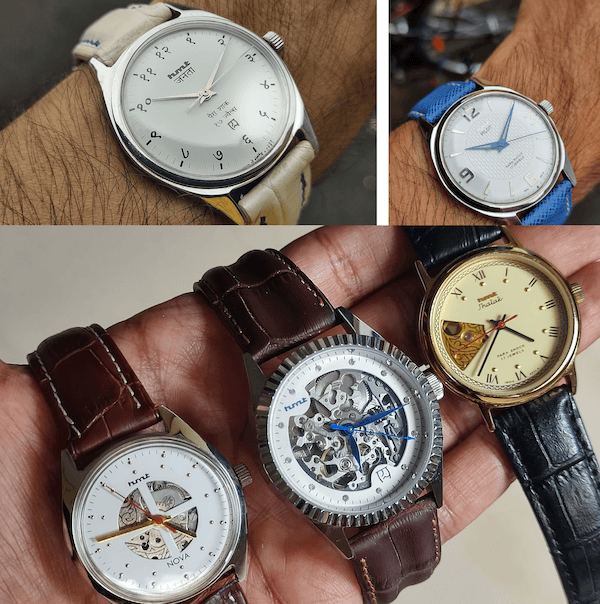
However when the closure of HMT was announced, the demand for vintage HMTs sprung up. Around 2010-2015, mechanical watches were almost sold out and the craze and secondary market prices shot up again in such a way that on one hand a collector was looking for a Rolex at MRP and on other hand was looking for a genuine HMT at MRP as well. HMT also started online sales in 2010 but by 2015 it was closed again. In 2019 HMT shifted to their Auxiliary Business Division and now only sells watches online, one showroom in Bangalore and HMT Museum memento center. There are latest designs launched by HMT watches with cases existing from previous stocks, hand-winding movements from old stock, imported Miyota automatic movements and dials procured through third party contracts. All of these are still assembled in HMT Bangalore and distributed through www.hmtwatches.in, which is their only genuine website. One may still find many old stock handwindings and automatics frequently available and a new range of high quality automatics and quartz watches through the website.
HMT watches has a long history, right from the beginning of Indian industries, development and evolution, to people's wrists and their daily lives, then right down to modern India and in the hands of collectors. Rarely one would see a brand being so celebrated, discussed, treasured, used and collected among a broad level of consumers and collectors in India and even around the world.
If you ask me about HMT watches, apart from being the author of this article, I would say that it is a treasured memento of Indian industrialization and the vision of great leaders, industrialists, visionaries and scientists who believed in making India self-reliant in industrial machines including watches. The first word in the abbreviation of HMT is "Hindustan" and that is what it represents, the people and the nation.
No articles found

